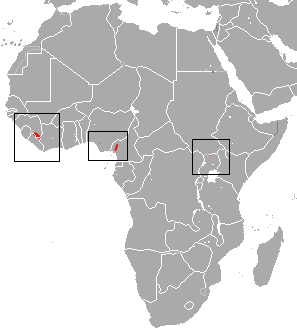Hills' horseshoe bat facts for kids
Quick facts for kids Hills' horseshoe bat |
|
|---|---|
| Conservation status | |
| Scientific classification | |
| Genus: |
Rhinolophus
|
| Species: |
hillorum
|
 |
|
| Hill's horseshoe bat range | |
The Hills' horseshoe bat (Rhinolophus hillorum) is a special type of bat. It belongs to a group known for their unique nose shapes, which look a bit like a horseshoe! These bats live in parts of Africa.
You can find the Hills' horseshoe bat in countries like Cameroon, Guinea, Liberia, and Nigeria. They like to live in warm, wet places. Their favorite homes are forests and cool, dark caves.
Contents
About the Hills' Horseshoe Bat
How Scientists Name Animals
Scientists have a special way to name and group all living things. This is called taxonomy. The Hills' horseshoe bat was first described in 1989. At first, scientists thought it was a type of another bat, the Geoffroy's horseshoe bat.
They gave it a long scientific name: Rhinolophus clivosus hillorum. But later, in 2002, they realized it was unique enough to be its own species. So, it got its own special name: Rhinolophus hillorum. It was named after two scientists, John Eric Hill and John Edwards Hill.
What Does This Bat Look Like?
The Hills' horseshoe bat is a medium-sized bat. Its forearm, which is like its wing bone, measures about 52 to 57 millimeters (about 2 to 2.2 inches). That's roughly the length of a small paperclip!
These bats usually weigh between 16.5 and 25 grams (about 0.6 to 0.9 ounces). That's about the same weight as a few quarters. They also have 28 teeth in their mouths, which helps them eat their food.
Where Do Hills' Horseshoe Bats Live?
Bat Homes and Habitats
The Hills' horseshoe bat lives in Western and Central Africa. We know for sure they are in Cameroon, Guinea, Liberia, and Nigeria. Scientists think they might also live in Uganda, but they haven't confirmed it yet.
These bats prefer to live in specific places. They like warm, moist lowland forests. They also live in mountain forests. Caves are very important to them. They use caves and other underground spots as safe places to rest and raise their young.
Protecting the Hills' Horseshoe Bat
Why This Bat Needs Our Help
As of 2022, the Hills' horseshoe bat is listed as "vulnerable" by the IUCN. This means it is at risk of becoming endangered. The main reason for this is habitat destruction. Their homes are disappearing.
Scientists believe there are not many of these bats left. Their numbers are also going down. Some of the biggest dangers to the Hills' horseshoe bat include:
- Mining and Quarrying: When people dig for minerals or stone, it can destroy the bats' homes, especially caves.
- Deforestation: Cutting down forests removes the trees and plants the bats rely on for food and shelter.
- Hunting: In some areas, these bats are hunted, which further reduces their population.
Protecting their forest homes and caves is very important to help these unique bats survive.


